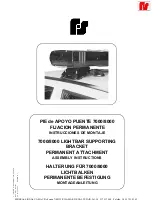
193
9
Technical data
It bears the following information:
- the name of the manufacturer,
- the European Whole Vehicle Type Approval
number,
- the vehicle identification number (VIN),
- the maximum authorised vehicle weight (the
Gross Vehicle Weight or GVW),
- the maximum authorised v trailer
weight (the Gross Train Weight or GTW),
- the maximum weight on the front axle,
- the maximum weight on the rear axle.
D.
Tyre/paint label.
This label is affixed to the centre pillar on the
driver’s side.
It bears the following information on the tyres:
- the tyre inflation pressures with and without
load,
- the tyre specification, made up of the
dimensions and type as well as the load and
speed indices,
- the spare tyre pressure.
It also indicates the paint colour code.
The vehicle may be originally equipped
with tyres with higher load and speed
indices than those indicated on the label,
without affecting inflation pressure.
Checking tyre pressures
The tyre pressures should be checked when
cold at least monthly.
The pressures given on the label are valid for
cold tyres. If you have driven for more than
10 minutes or more than 6 miles (10 kilometres)
at more than 30 mph (50 km/h), the tyres will be
warm; in this case 0.3 bar (30 kPa) should be
added to the pressures given on the label.
Never reduce the pressure of a warm tyre.
Low tyre pressures increase fuel
consumption.
Summary of Contents for 208 2017
Page 1: ...PEUGEOT 208 HANDBOOK...
Page 196: ......
Page 239: ...43 PEUGEOT Connect Nav...
Page 240: ...44 PEUGEOT Connect Nav...
Page 241: ...45 PEUGEOT Connect Nav...
Page 242: ......
Page 268: ...26 PEUGEOT Connect Radio...
Page 269: ...27 PEUGEOT Connect Radio...
Page 270: ......
Page 286: ......
Page 301: ......
Page 302: ......
















































